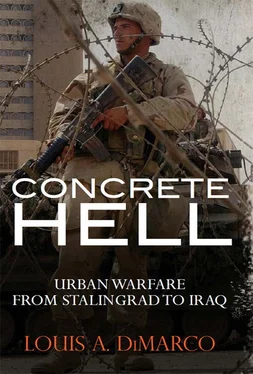The initial landing area at Inchon was opposed by about 2,000 troops. The KPA had a total of about 16,000 troops in the Inchon–Seoul area. This was a relatively light defensive force given the area’s strategic importance, but it reflected the North Korean high command’s focus on the battles in the south around the Pusan perimeter. In addition to the 2,000 troops positioned in the area of Inchon, another 2,000 troops of the 87th Infantry Regiment were positioned to defend the major suburb of Seoul at Yongdungpo. Additionally, Seoul was garrisoned and defended by the Seoul Defense Division, a unit of approximately 10,000 troops. The remainder of the initial KPA forces around the capital were various support units. Not part of the Seoul garrison, but able to respond quickly to any threat to the city or an amphibious landing, was the KPA’s theater reserve, the 105th Tank Division, equipped with T-34/85 tanks. This unit was the premier unit of the KPA, equipped with over 50 tanks, supporting artillery, and antitank and infantry subunits. It was refitting near Seoul when the landings at Inchon occurred.
On September 15, the 1st Marine Division landed two regimental combat teams (RCTs), the 1st and the 5th Marine Regiments, south and north of the city of Inchon respectively. The landings, unusually, took place late in the afternoon, due to the tides. The two regiments secured their initial objectives quickly, overcoming relatively light resistance in Inchon itself. The North Korean defenders were surprised, shocked by the pre-invasion naval and air bombardment, and gave up all resistance during the night. The next day the 5th Marines marched through the abandoned city of Inchon to link up with the 1st Marines and begin the 18-mile movement to the capital of Seoul. The 1st Marines were directed to advance directly west with the objective of securing Yongdungpo, the major suburb of Seoul on the west bank of the Han River. The 5th Marines veered north to secure Kimpo Airfield, the major air terminal of the capital and the largest and most modern airfield on the peninsula, also on the west side of the river.
By September 17, the 5th Marines were in position to attack Kimpo Airfield. Fighting through scattered North Korean strongpoints, the RCT secured the southern edge of the airfield by the end of the day. To the south the 1st RCT fought its way through a series of North Korean roadblocks on the main Inchon–Seoul highway. By nightfall the 1st RCT had advanced about two miles.
During the night the North Koreans defending Kimpo staged several small-scale counterattacks against the Marines, all of which were beaten off successfully. In the morning of September 18 the Marines advanced across the airfield against light resistance and by 10am the airfield and surrounding villages were secure. On September 18 the first troops of X Corps’ 7th Infantry Division began to land at Inchon. Their mission was securing the major highway south of Seoul that was the lifeline of the North Korean army fighting desperately at Pusan.
As the Marines closed in on the west bank of the Han River north of Seoul, the plan to recapture the city developed. The first phase of the plan involved securing a bridgehead on the east bank and bringing the entire west bank under control of the Americans. On September 20, the 5th Marine RCT crossed the Han north of Seoul and then wheeled right and began to attack the city from the north to the south. Simultaneously the 1st RCT entered Yongdungpo and began a building by building attack to clear the west bank of the Han. By September 23, the 1st RCT had accomplished its mission and was prepared to join the 5th Marines on the east bank.
The river assault of the 5th RCT was only lightly opposed. The Marines were mounted in LVTs (Landing Vehicles Tracked), literally amphibious armored personal carriers. These vehicles and crews were provided by the Marine 1st Amphibious Tractor Battalion, and the US Army’s 56th Amphibious Tractor Company. In addition, some Marines at Inchon and at the crossing of the Han River rode in army DUKW amphibious trucks of the 1st Amphibious Truck Company. Importantly, X Corps had no assault-bridging capability, so they could not put a military bridge over the Han. This meant that it was very time-consuming to move the important M-26 tanks of the 1st Marine Tank Battalion across the river to support the 5th RCT. Finally, as the plan was fashioned, four RCTs would participate in the battle of Seoul, each attacking in a set sequence. The sequencing of these attacks was all determined by the requirement that all four RCTs be moved across the river by the same single LVT battalion. Thus, the Han River obstacle shaped the assault on Seoul more than any other single factor.
The intent of the attack of the 5th RCT was to get behind the defenses of Seoul as the assumption was that the North Korean forces would be oriented south and southwest towards the approaches directly from Inchon. What the planners of the operation failed to account for was that the area northwest of Seoul was a former Japanese army training area, and had been improved by the South Korean army as a defensive line, so the positions were oriented north against attack from North Korea. Those prepared defensive positions were still in place and the North Korean army occupied them in defense against the attack of the 5th RCT. In addition, the North Korean army moved approximately 10,000 troops into these positions just prior to the Marines crossing the Han. Thus, though the 5th RCT covered 4 miles on the afternoon of river crossing, September 20, it then ran into stiff resistance. It would take the Marines five more days to fight their way across the last four miles of ridges between their landing site and Seoul.
On September 24, the 1st RCT crossed the river, assaulting directly from Yongdungpo into the heart of the city. With three battalions abreast, the 1st RCT attacked directly east through a series of roadblock barricades that the North Koreans had constructed on the major thoroughfares through the city. The 5th RCT wheeled left, and advanced on the left flank of the 1st RCT as both Marine units systematically cleared barricades, buildings, culverts, and sewers. Both regiments used their M-26 Pershing tanks extensively. Typically a single tank led a Marine infantry platoon as it systematically cleared the interiors of the buildings. The Marine tanks were virtually unstoppable, and easily brushed aside North Korean infantry, and also made short work of a few Soviet-built T-34/85 tanks found in the city.
On September 25, two additional regiments entered the battle for Seoul. One was the 32nd Infantry Regiment of the US Army’s 7th Infantry Division. The other was the 1st ROK Infantry Regiment, attached to the 7th Infantry Division. These two regiments, using the same LVTs as the 1st and 5th RCTs, crossed the Han River into the southern part of Seoul. Thus by September 25, the four allied regiments were on line advancing across Seoul. On the night of September 25–26, the North Korean army mounted a last major counterattack against the 5th, 1st, and 32nd Regiments. The attack against the 1st Marines was led by T-34 tanks and self-propelled assault guns. In the morning the two Marine regiments counted almost 500 enemy dead as well as nine destroyed armored vehicles and eight antitank guns in front of their positions. The steady advance of the three major regiments, supported by the 17th ROK Army Regiment, continued on September 26, and on September 27 the major portion of the city was cleared of communist forces and the X Corps lead elements were pursuing the enemy north through the mountains toward the 38th parallel. It had required 12 days for the X Corps to achieve its objective after landing at Inchon.
The only other major combat formation involved in the battle for Seoul was the 7th Marine Regiment of the 1st Marine Division. This regiment was still en route to Korea when the initial Inchon landings occurred. It landed at Inchon on September 21. The 7th Marines’ role in the Seoul operation was to isolate the city and prevent North Korean forces from escaping the city to the northeast. As the 5th Marines attacked into the city from the north the 7th Marines passed behind them and attacked east. Unfortunately, the direction of attack to the east was across numerous valleys divided by very rugged mountains aligned north to south, and the area was virtually unsupported by roads. Thus, though not strongly opposed, the attack proceeded very slowly. It was only on September 28 that the northeast escape routes were closed, and by then some of the best North Korean troops defending Seoul had escaped.
Читать дальше












